 W
WAnoplodesmus is a genus of millipedes. It is one of the most species rich genera in the family Paradoxosomatidae, with over 40 described species distributed from India and Nepal to China and Southeast Asia, as well as the Mascarene Islands and Fiji.
 W
WAnoplodesmus anthracinus is a species of millipedes in the family Paradoxosomatidae. It was previously thought to confined to Myanmar, the species was reported and documented from Malaysia and Sri Lanka in 2013.
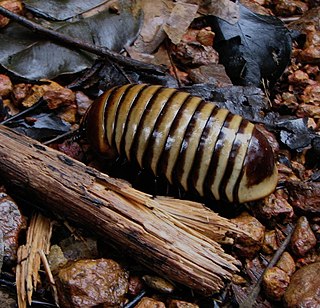 W
WArthrosphaeridae is a family of giant pill millipedes that are found in Madagascar, the Western Ghats of India, and Sri Lanka. The largest pill-millipede in the world, Zoosphaerium neptunus belongs to this family and is known to swarm at certain times of the year.
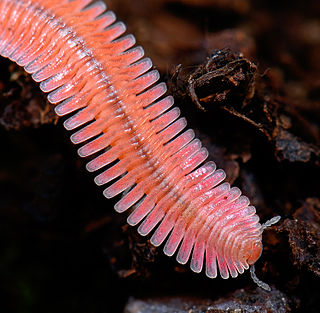 W
WBrachycybe (Greek for "short head") is a genus of andrognathid millipedes with species in the United States and East Asia. In a rare example of paternal care in invertebrates, males of most species guard the eggs until they hatch.
 W
WBrachyiulus is a genus of millipedes, containing around eight species, most of which live in the Mediterranean Basin of Europe and Asia. The species B. pusillus has been introduced widely around the world
 W
WChamberlinius is a genus of flat-backed millipedes in the family Paradoxosomatidae. There are five species; 3 of which occur only Taiwan, one only in the Ryukyu Islands of southeast Japan, and one occurring in both areas. Individuals are 25–37 mm (0.98–1.46 in) long and up to 5.5 mm wide, colored in pale yellow to brown, sometimes with dark brown markings on the anterior portion of body segments.
 W
WDesmoxytes, whose species are commonly known as the dragon millipedes, is a genus of millipede of the family Paradoxosomatidae found in southeast Asia. The genus was described by Ralph Vary Chamberlin in 1923 and reviewed by Sergei Golovatch and Henrik Enghoff in 1994. At least twenty-nine species are known from southeastern China to Myanmar, Thailand, and Vietnam. One species, D. planata, has also been observed in Sri Lanka, the Andaman Islands, Seychelles, Java, Great Coco Island, and Fiji; however, this species has expanded its range by being transported through human activity. Several species have only recently been discovered and some have yet to be officially described.
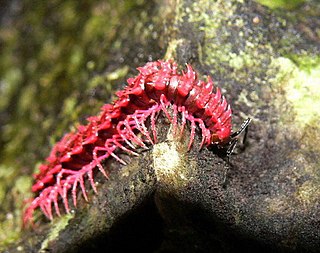 W
WDesmoxytes purpurosea also known as dragon millepede, is a spiny and toxic millipede named for its vivid pink color. It was formally described in 2007 from a specimen collected at the Hup Pa Tard limestone cavern in the Uthai Thani Province of Thailand. Among the largest species of its genus, the adult millipede is approximately 3 cm (1.2 in) long. It lives in the open on leaf litter. Large numbers of them occur after rain showers. The millipede has glands that produce hydrogen cyanide to protect it from predators, which causes it to smell like almonds. Its toxicity is advertised by its aposematic color.
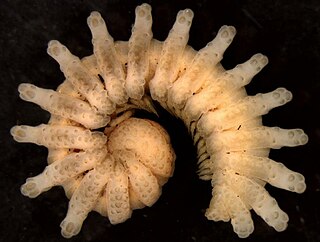 W
WEutrichodesmus is a genus of millipedes in the family Haplodesmidae, containing at least 32 species in China, Taiwan, and Southeast Asia.
 W
WGonatotrichus minutus is a species of millipede in the family Siphonophoridae, described in 1922 by the Swiss zoologist Johann Carl. The species is endemic to Malaysia. Individuals are very small, around 5 millimetres (0.20 in) long and, 0.7 mm wide, with around 40 body segments. The color is brownish-yellow, with lighter-colored legs. It differs from other Malaysian siphonophorids by its small size, the aspect ratio of its beak and antennae and the shape of the front gonopods.
 W
WThe greenhouse millipede, also known as the hothouse millipede, short-flange millipede, or garden millipede, is a species of millipede in the family Paradoxosomatidae that has been widely introduced around the world, and is sometimes a pest in greenhouses.
 W
WHaplodesmidae is a family of millipedes in the order Polydesmida. Species occur in East Asia, Southeast Asia, and Oceania, although some species have been introduced to the New world tropics. Species are small bodied, often with elaborate sculpturing on the tergites, and some species are capable of rolling into a near-complete ball.
 W
WOrthomorpha is a genus of millipedes in the family Paradoxosomatidae containing approximately 50 species distributed in Southeast Asia.
 W
WOrthomorpha coarctata, the long-flange millipede, is a widely introduced species of Polydesmidan millipede of the family Paradoxosomatidae. It is presumed native to Southeast Asia but due to transport by humans occurs in tropical and sub-tropical areas throughout the world, including the Hawaiian Islands, the West Indies, Gulf Coast of North America, and the Galápagos Islands.
 W
WParafontaria is a genus of "flat-backed" millipedes consisting of 13 species native to Japan, where they are known as train millipedes. Some species exhibit periodical swarming behavior during which large numbers of individuals congregate and can sometimes slow or derail trains when they occur on tracks. Individuals vary from around 3.5 to 6 cm as adults, and feed on leaf litter as well as soil, making them comparable to earthworms in facilitating decomposition and soil nutrient cycling.
 W
WSinocallipus is a genus of predominantly cave-dwelling millipedes in the order Callipodida. Five of the six known species are found in limestone caves on the Indochinese Peninsula from Vietnam to southern China, and it is the only callipodidan genus entirely confined to the tropics. Individuals range from 40–70 mm (1.6–2.8 in) long and possess 55 to 70 segments. Sinocallipus is the sole taxon of the callipodidan suborder Sinocallipodidea, and thought to be the most primitive and sister group to all other callipodidans. In contrast to many other millipede groups, the gonopods of Sinocallipus show little variation between species, while other characters such as color, size, and other body parts differ more noticeably between species.
 W
WSiphoniulus is a poorly known genus of millipede containing only two living species: S. alba from Indonesia, and S. neotropicus from Mexico and Guatemala. An additional two fossil species are known from Cretaceous amber. Siphoniulus species are the only members of the family Siphoniulidae and order Siphoniulida, making Siphoniulida the smallest millipede order. Few specimens are known, and their classification is contentious, although most recent studies place them as basal members of the Helminthomorpha.
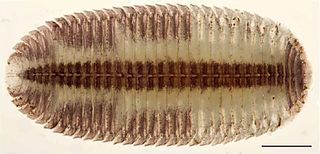 W
WSiphonocryptida is an order of millipedes, comprising the sole family Siphonocryptidae. With only seven described species, the Siphonocryptida is the second smallest millipede order, surpassed only by Siphoniulida, with two species.
 W
WSphaeropoeus is a genus of giant pill millipedes belonging to the family Zephroniidae.
 W
WSphaeropoeus hercules is a species of giant pill millipede belonging to the family Zephroniidae.
 W
WTermitodesmus ceylonicus is a species of millipede in the family Glomeridesmidae. It is endemic to Sri Lanka.
 W
WThyropygus is a genus of millipedes in the family Harpagophoridae, widely distributed throughout Southeast Asia. With over 50 named species, it is the most-species rich genus of Harpagophoridae in Southeast Asia. Over 30 species occur in Thailand.
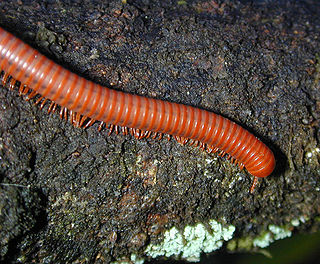 W
WTrigoniulus corallinus, sometimes called the rusty millipede or common Asian millipede, is a species of millipede widely distributed in the Indo-Malayan region including India, Sri Lanka, China, Taiwan, Myanmar, Thailand, Vietnam, Malaysia, Singapore, and much of Indonesia. It is also reported from Fiji and Tanzania and found in South Asia and the Caribbean as an introduced species. In some part of India it is feared, people there in summertime sleep on their floor on mat, and this millipede crawl into ear and nose cavity, which can be very harmful. Because of modernisation, it is unlikely to happen today.
 W
WXenobolus is a genus of millipedes in the family Pachybolidae, containing two species found in India and Sri Lanka. The species are unusual within the Pachybolidae in being boldly colored with red bands or spots on a blackish background color.
 W
WXenobolus carnifex is a species of spirobolidan millipede found in South India and Sri Lanka. It is a common species and can become a household pest, infesting and damaging thatched roofs, creating a "continual shower of faecal pellets", and invading food and water supplies. X. carnifex ranges from 58 to 65 mm in length, with 48 to 50 body segments. The body color is dark or black, with a band of red or pink running down the dorsal midline.
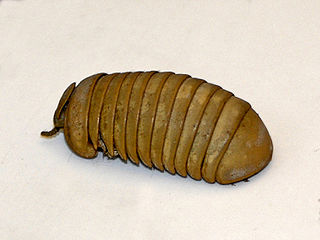 W
WZephronia is a genus of giant pill millipedes in the family Zephroniidae. This genus include 37 species distributed in N. India, Myanmar, Malayan Peninsula, Java, Sumatra and Borneo.
 W
WZephroniidae is a family of giant pill millipedes in the taxonomic order Sphaerotheriida. They occur in southeast Asia from the Himalayas and China south and east to Sulawesi and to Australia, and also inhabit some Philippine islands.